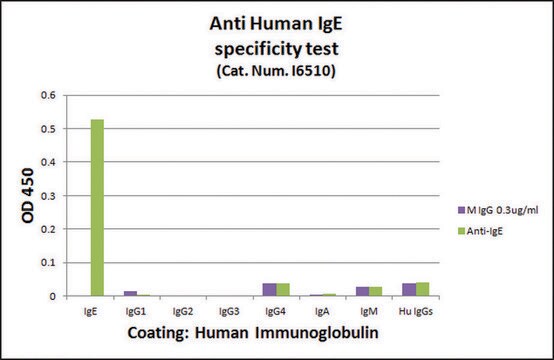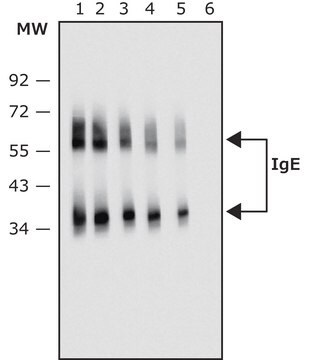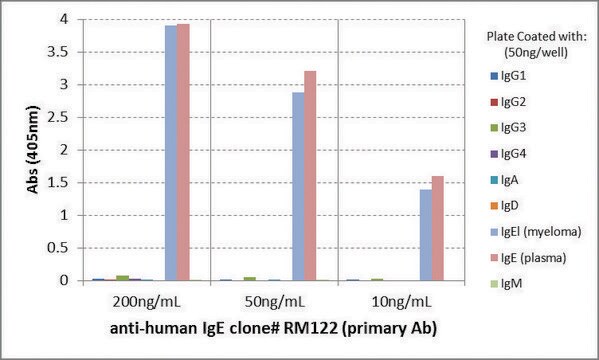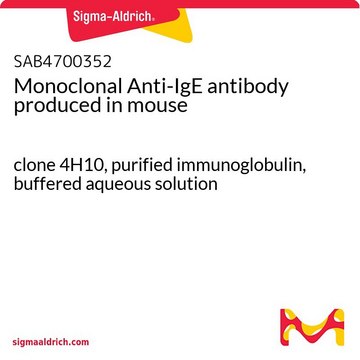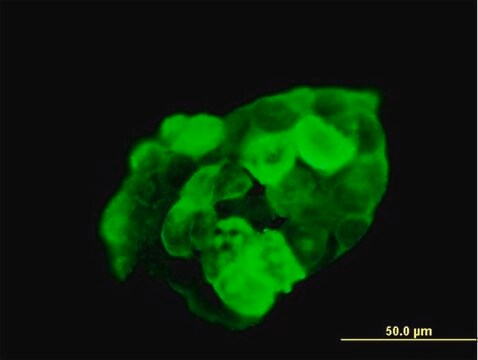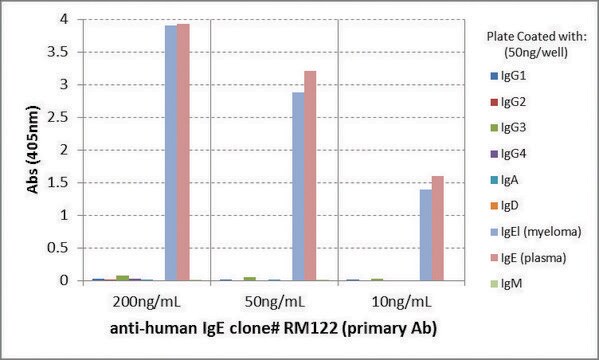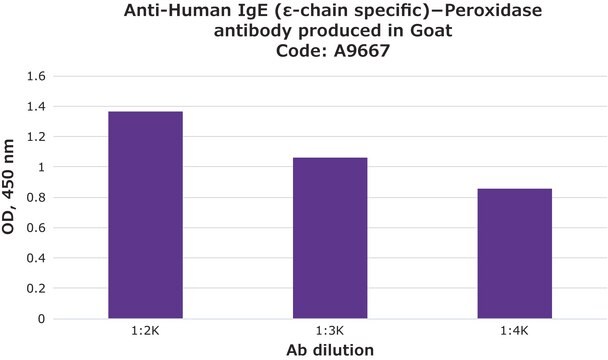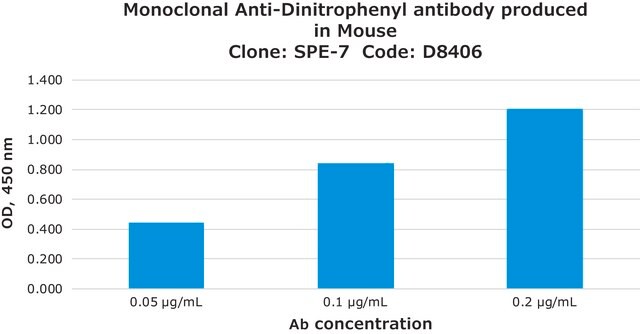SAB4700351
Monoclonal Anti-IgE antibody produced in mouse
clone BE5, purified immunoglobulin, buffered aqueous solution
Synonym(s):
Anti-IGHE
Sign Into View Organizational & Contract Pricing
All Photos(1)
About This Item
UNSPSC Code:
12352203
NACRES:
NA.41
Recommended Products
biological source
mouse
Quality Level
conjugate
unconjugated
antibody form
purified immunoglobulin
antibody product type
primary antibodies
clone
BE5, monoclonal
form
buffered aqueous solution
species reactivity
human
concentration
1 mg/mL
technique(s)
flow cytometry: suitable
isotype
IgG1
NCBI accession no.
UniProt accession no.
shipped in
wet ice
storage temp.
2-8°C
target post-translational modification
unmodified
Gene Information
human ... IGHE(3497)
General description
Immunoglobulin E (IgE) is encoded by the gene mapped to human chromosome 14q32.33. IgE belongs to the immunoglobulin family and consists of epsilon(ε) heavy chain in the constant (C) region. IgE has a monomeric structure with an extra domain in the constant region.
The antibody BE5 reacts with human IgE; it recognizes an epitope different from the ones recognized by 4G7 and 4H10 antibodies to IgE.
Immunogen
Purified human IgE
Application
The reagent is designed for Flow Cytometry analysis. Suggested working dilution is 5 μg/mL of sample. Indicated dilution is recommended starting point for use of this product. Working concentrations should be determined by the investigator.
Biochem/physiol Actions
Immunoglobulin E (IgE) binds very tightly to Fc receptors on basophils and mast cells. Thus, it plays a major role in stimulating allergic reactions. Elevated expression of the gene has been associated with the development of hyper IgE Syndrome (HIES), hay fever, atopic skin diseases such as eczema, anaphylactic shock and IgE-myeloma. In addition, overexpression of IgE is also observed in allergy/asthma. Therefore, increased levels of serum IgE can be considered as a diagnosis for asthma. IgE expression is down-regulated in congenital agammaglobulinemia and hypogammaglobulinemia because of faulty metabolism or synthesis of immunoglobulins.
Features and Benefits
Evaluate our antibodies with complete peace of mind. If the antibody does not perform in your application, we will issue a full credit or replacement antibody. Learn more.
Physical form
Solution in Tris buffered saline, pH 8.0, with 15 mM sodium azide.
Disclaimer
Unless otherwise stated in our catalog or other company documentation accompanying the product(s), our products are intended for research use only and are not to be used for any other purpose, which includes but is not limited to, unauthorized commercial uses, in vitro diagnostic uses, ex vivo or in vivo therapeutic uses or any type of consumption or application to humans or animals.
Not finding the right product?
Try our Product Selector Tool.
Storage Class Code
10 - Combustible liquids
WGK
WGK 1
Flash Point(F)
Not applicable
Flash Point(C)
Not applicable
Choose from one of the most recent versions:
Already Own This Product?
Find documentation for the products that you have recently purchased in the Document Library.
T Gülen et al.
Clinical and experimental allergy : journal of the British Society for Allergy and Clinical Immunology, 44(9), 1179-1187 (2014-07-22)
The mechanisms by which mast cells in patients with unexplained anaphylaxis (UEA) are triggered remain elusive. Onset of episodes is unpredictable and often recurrent. The substantial overlap between the clinical manifestations of UEA and clonal mast cell disorders (CMD) suggests
Hans D. Ochs, C. I. Edward Smith, Jennifer M.
Primary Immunodeficiency Diseases: A Molecular and Cellular Approach (2006)
Binie Ver Lipps
Immunoglobulin E (Ige): Novel Treatment for Lowering the Concentration of Ige (2009)
N. Franklin Adkinson, Jr., Bruce S. Bochner, Wesley Burks, William W. Busse, Stephen T. Holgate
Middleton's Allergy: Principles and Practice
(2013)
Adriana Turqueti-Neves et al.
European journal of immunology, 44(7), 2130-2138 (2014-04-30)
Infection with helminths and exposure to antigens induce a strong type 2 immune response resulting in the secretion of the cytokines IL-4 and IL-13 by CD4(+) T cells and several innate cell types. IL-4 and IL-13 promote class switch recombination
Our team of scientists has experience in all areas of research including Life Science, Material Science, Chemical Synthesis, Chromatography, Analytical and many others.
Contact Technical Service